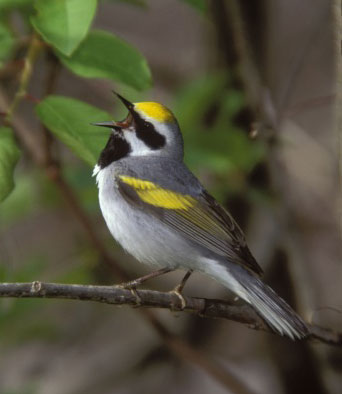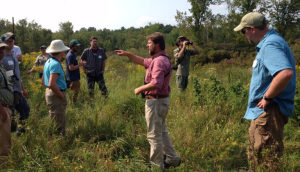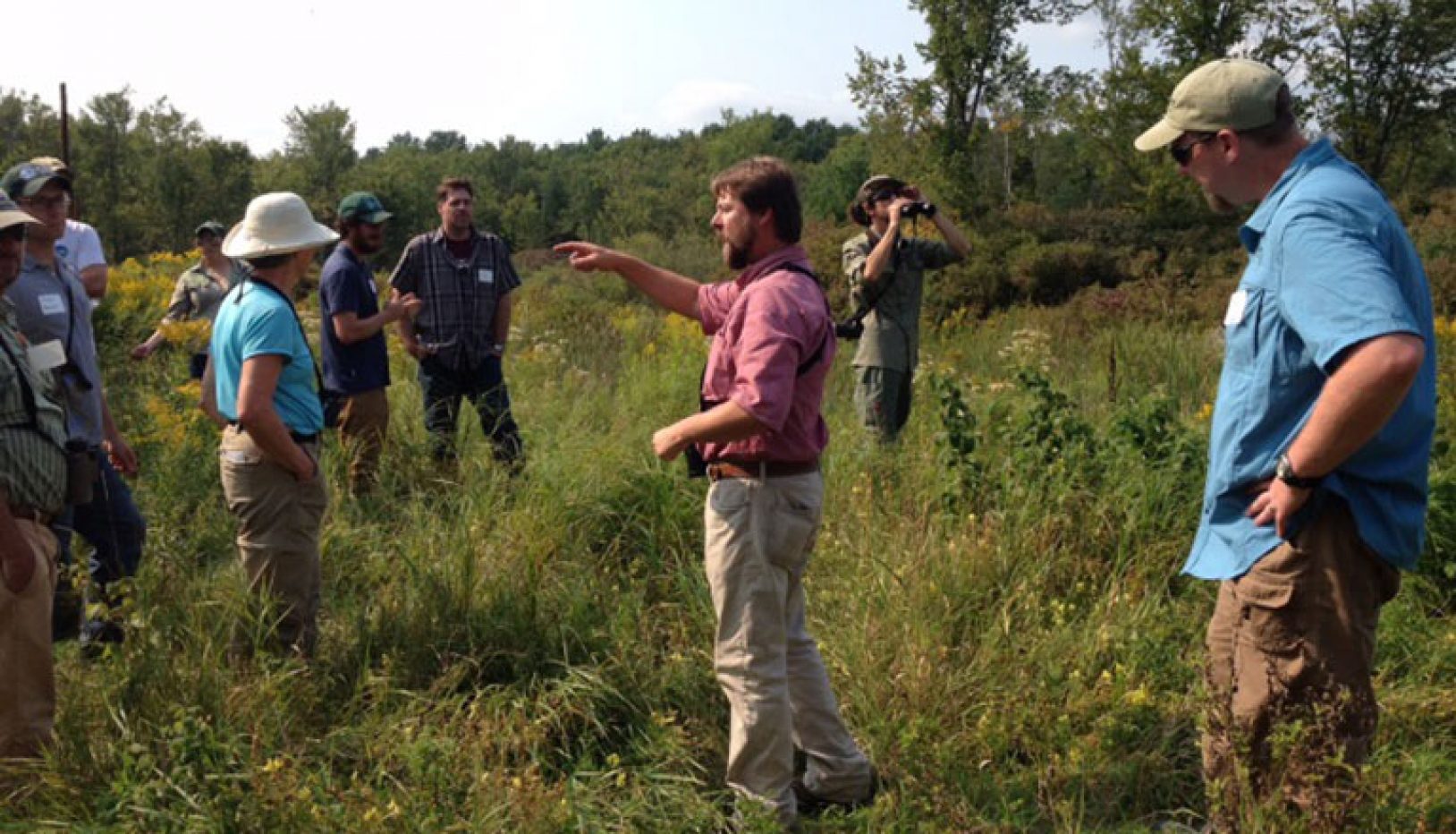Due to a high concentration of grasslands, wetlands, and shrublands, the St. Lawrence Valley of New York is one of the most critical regions for grassland and early successional forest birds in the Eastern United States. However, large contiguous blocks of these habitats are being fragmented rapidly by human development, roads, and agricultural fields due to the expansion of Fort Drum, an influx of seasonal residents and visitors, and an uptick in intensive agricultural practices. The irreversible loss of these habitats and the connectivity among them can significantly impact birds and other wildlife in the region.
Because most of the St. Lawrence landscape is under private ownership, a valuable opportunity exists for land trusts to create a matrix of private, protected lands that can promote land stewardship for maintaining biodiversity and preserve habitats for high priority species experiencing rapid population declines, such as the Henslow’s Sparrow and Golden-winged Warbler.
The Golden-winged Warbler population is sharply declining with an estimated 400,000 breeding adults remaining globally, a drop of 66 percent since the 1960s. The St. Lawrence Valley supports the largest hold of breeding Golden-winged Warblers in New York; this is also one of the eastern-most population segments connected to the larger Great Lakes population. The connection between the privately held agricultural and forest lands of the St. Lawrence Valley and the declining Golden-winged Warbler provides a unique opportunity to bring bird conservation partners and land trusts together.

The Golden-winged Warbler population is in sharp decline due to lack of natural disturbances, too little forest management, and habitat loss from human development. Photo: Roger Eriksson
Why are land trusts natural partners for birds? To start, they manage 24 million acres of eastern forests, generate management plans to protect or enhance wildlife habitat, and provide an ideal mechanism for connecting with local landowners who may be interested in conservation.
In 2012, the Thousand Islands Land Trust and the Indian River Lakes Conservancy met with staff from Clarkson University, Audubon New York, New York Department of Environmental Conservation (NY DEC), and Cornell Lab of Ornithology. They visited sites in the St. Lawrence Valley and investigated how best to engage in conservation of the Golden-winged Warbler and other birds within this distinctive shrubland and young forest ecosystem. In 2013, Clarkson, Audubon, NY DEC, and Cornell supported the two land trusts in writing a multi-partner grant to establish three Golden-winged Warbler demonstration areas—two on land trust properties and one on a state wildlife management area in Jefferson and St. Lawrence counties. With letters of support from the bird conservation community and justifications from the Golden-winged Warbler Conservation Plan and New York State Wildlife Action Plan, the land trusts acquired funds from the Farm Bill’s 2014 Conservation Partnership Program. Thus, the St. Lawrence Valley Partnership (SLVP) for Golden-winged Warblers was formed.
The collaborative SLVP is focused on three main goals: (1) raising awareness among a variety of audiences about the importance of the St. Lawrence Valley for breeding Golden-winged Warblers through education and outreach; (2) carrying out management and maintaining habitat for this imperiled species on both private and state lands; and (3) training land managers at demonstration sites to recognize and manage habitat according to best management practices for a suite of early-successional species.

A Cornell Lab of Ornithology biologist discusses young forest habitat suitable for Golden-winged Warblers at the Grand Lake Reserve during the St. Lawrence Valley Partnership Habitat Management Workshop. Photo: Ashley Dayer
All partners bring significant and diverse skills to the table to accomplish these common goals. Audubon, Clarkson University, and the Cornell Lab conducted pre-monitoring bird and habitat surveys at proposed implementation sites prior to management. Audubon drafted site specific management plans according to Golden-winged Warbler best management practices, which in turn guided landowners’ management actions. The land trusts and NY DEC shared resources and machinery to carry out restoration work laid out by a management plan on both agricultural and forest lands, including activities such as thinning, non-native shrub removal, and woody material plantings. All partners are working collaboratively to develop interpretative panels stationed at each of the three sites for the general public. These partners also hosted a two-day Golden-Winged Warbler Habitat Management Workshop that showcased the demonstration areas and taught land managers and resource professionals about the ecology, management, monitoring, and human dimensions of Golden-winged Warbler conservation. Nearly 40 professionals attended the workshop, including the NY DEC’s new Young Forest Initiative team and staff from various land trusts in NY and VT.
The SLVP is helping land trusts to achieve their goals of expanding land conservation and stewardship efforts and increasing community support for this important work throughout the region. Here is what two SLVP land trust representatives are saying about the benefits of this collaborative:
“This partnership has been a great way for organizations, like Thousand Islands Land Trust, to stay on top of the latest conservation issues. It has helped us to build our capacity for completing sophisticated habitat restoration initiatives and has created not only a local focus for Golden-winged Warblers and shrubland species, but has also connected us regionally into Vermont. It has also given us a chance to assess our land trust lands and select sites appropriate for shrubland management in order to increase available habitat for these struggling species, making our existing habitat restoration efforts for birds more robust. By working together, we are raising awareness about shrubland species and helping to educate other land managers and private landowners to also join in this effort to have a big impact for a small bird and its associated species and wildlife.” — Sarah Walsh, Thousand Islands Lands Trust
“Our collaboration with the Cornell Lab and NY Audubon through the SLVP has provided the Indian River Lakes Conservancy with a wealth of professional expertise and on-site guidance that has greatly enhanced our ability to productively manage our land for the benefit of future generations. Most significantly, it has heightened our appreciation for the importance of managing the successional stages of growth on those lands to support the widest possible range of native biodiversity, especially those species like the Golden-winged Warblers that are suffering from the loss of suitable shrubland habitat.” — Mark Scarlett, Indian River Lakes Conservancy
Private landowners and land trusts in the St. Lawrence Valley can take great pride in their ongoing stewardship of the Golden-winged Warbler—their work is restoring important habitat for this and other species of conservation concern and protecting a landscape rich in birds and other wildlife for generations to come.

